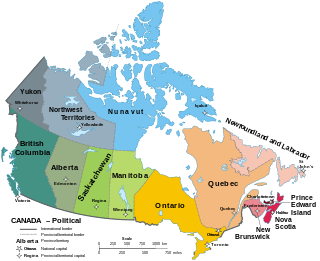
Canada has ten provinces and three territories that are sub-national administrative divisions under the jurisdiction of the Canadian Constitution. In the 1867 Canadian Confederation, three provinces of British North America—New Brunswick, Nova Scotia, and the Province of Canada —united to form a federation, becoming a fully independent country over the next century. Over its history, Canada's international borders have changed several times as it has added territories and provinces, making it the world's second-largest country by area.
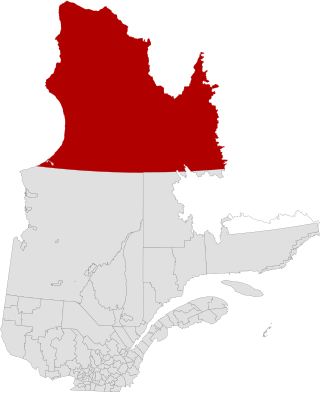
Nunavik is an area in Canada which comprises the northern third of the province of Quebec, part of the Nord-du-Québec region and nearly coterminous with Kativik. Covering a land area of 443,684.71 km2 (171,307.62 sq mi) north of the 55th parallel, it is the homeland of the Inuit of Quebec and part of the wider Inuit Nunangat. Almost all of the 14,045 inhabitants of the region, of whom 90% are Inuit, live in fourteen northern villages on the coast of Nunavik and in the Cree reserved land (TC) of Whapmagoostui, near the northern village of Kuujjuarapik.

Pond Inlet is a small, predominantly Inuit community in the Qikiqtaaluk Region of Nunavut, Canada, located on northern Baffin Island. To the Inuit the name of the place "is and always has been Mittimatalik." The Scottish explorer Sir John Ross had named an arm of the sea that separates Bylot Island from Baffin Island as Pond's Bay, and the hamlet now shares that name. On 29 August 1921, the Hudson's Bay Company opened its trading post near the Inuit camp and named it Pond Inlet, marking the expansion of its trading empire into the High Arctic.

An inuksuk or inukshuk is a type of stone landmark or cairn built by, and for the use of, Inuit, Iñupiat, Kalaallit, Yupik, and other peoples of the Arctic region of North America. These structures are found in northern Canada, Greenland, and Alaska. This combined region, north of the Arctic Circle, is dominated by the tundra biome and has areas with few natural landmarks.
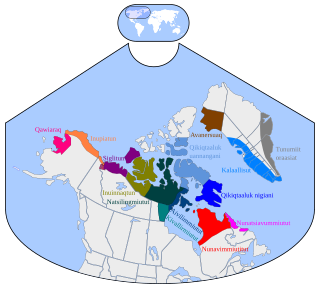
Inuktitut, also known as Eastern Canadian Inuktitut, is one of the principal Inuit languages of Canada. It is spoken in all areas north of the North American tree line, including parts of the provinces of Newfoundland and Labrador, Quebec, to some extent in northeastern Manitoba as well as the Northwest Territories and Nunavut. It is one of the aboriginal languages written with Canadian Aboriginal syllabics.
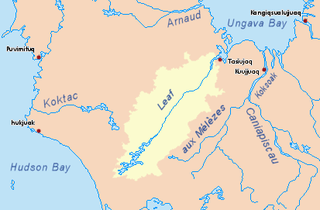
Leaf River is a river in northern Quebec, Canada, at the northern limit of the tree line. It flows from Lake Minto northeast through the Ungava Peninsula into Leaf Bay off Ungava Bay over a distance of 480 kilometres (300 mi). At the head of Leaf Bay is the Inuit community of Tasiujaq.

Umiujaq is a northern village near the eastern shore of Hudson Bay in Nunavik in northern Quebec, Canada. The village was established in 1986 by Inuit from Kuujjuarapik, 160 km to the south, who decided to relocate away from the area affected by the James Bay Hydro-electric Project. The population in the Canada 2021 Census was 541.
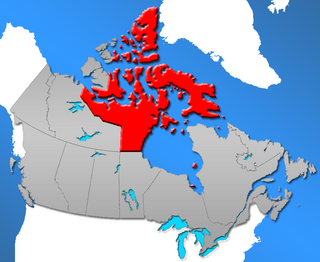
Nunavut is a territory of Canada. It has a land area of 1,877,787.62 km2 (725,017.85 sq mi). It has a population of 36,858 in the 2021 Census. In the 2016 census the population was 35,944, up 12.7% from the 2011 census figure of 31,906. In 2016, 30,135 people identified themselves as Inuit, 190 as North American Indian (0.5%), 165 Métis (0.5%) and 5,025 as non-aboriginal (14.0%).

Tasiujaq is a northern village in Nunavik, in northern Quebec, Canada. Its population in the Canada 2021 Census was 420.
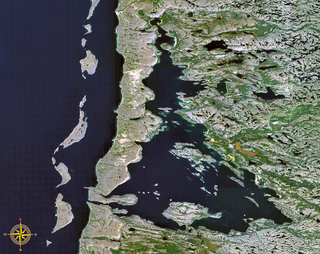
Lake Tasiujaq is a large triangular-shaped inland bay located on east side of Hudson Bay just above 56th parallel north in Quebec, Canada. It was formerly known as Richmond Gulf in English and Lac Guillaume-Delisle in French.

Kangiqtugaapik formerly Clyde Inlet is a body of water in eastern Baffin Island, Qikiqtaaluk Region, Nunavut. Its mouth opens into the Davis Strait from the west.
Tasiujaq formerly Murray Maxwell Bay is an uninhabited waterway in the Qikiqtaaluk Region, Nunavut, Canada. It is located in the Foxe Basin, north of Siuraarjuk on Baffin Island. The island of Kapuiviit lies at the opening of the bay.
Boatswain Bay is an uninhabited waterway in the Qikiqtaaluk Region of Nunavut, Canada. It extends eastward from James Bay into the headland, a part of Quebec.

Tasiujaq formerly Eclipse Sound is a natural waterway through the Arctic Archipelago within the Qikiqtaaluk Region, Nunavut, Canada. It separates Bylot Island from Baffin Island. To the east, it opens into Baffin Bay via Pond Inlet, and to the north-west into the Navy Board Inlet.

Inuit Nunangat refers to the land, water, and ice of the homeland of Inuit in Canada. This Arctic homeland consists of four northern Canadian regions called the Inuvialuit Settlement Region, the territory Nunavut (ᓄᓇᕗᑦ), Nunavik (ᓄᓇᕕᒃ) in northern Quebec, and Nunatsiavut of Newfoundland and Labrador.
Tasiujaq is an Inuit reserved land in Nunavik, in northern Quebec. Like all Inuit reserved lands in Quebec, it has no resident population and is associated with a nearby northern village of the same name: Tasiujaq.
Kuugjuaq is an Inuit language name and may refer to:
Tasiujaq, formerly Igloo Bay, is an uninhabited bay of Baffin Island in the Qikiqtaaluk Region, Nunavut, Canada. It flows into Inugsuin Fiord and then into Kangiqtugaapik and onto Davis Strait. The community of Clyde River is located 35 km (22 mi) northwest.












